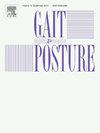跑步引起的疲劳影响下肢肌肉协同和相关的生物力学。
IF 2.2
3区 医学
Q3 NEUROSCIENCES
引用次数: 0
摘要
背景:疲劳改变肌肉激活模式是多关节运动中的一种适应策略。然而,由于参与跑步的肌肉群众多,疲劳前后的跨肌肉神经调控尚不清楚。中枢神经系统可能采用低维模块结构(即肌肉协同作用)来描述跑步等多关节运动中的肌肉协调:本研究旨在探讨疲劳对跑步时下肢肌肉协同作用和生物力学特征的影响:方法:招募 12 名健康男性参与者。在跑步机上以 12 km/h 的速度同步记录九块肌肉(即臀大肌、股二头肌、股直肌、内侧大肌、外侧大肌、胫骨前肌、内侧腓肠肌、外侧腓肠肌和比目鱼肌)的运动学、动力学和表面肌电图数据。采用非负矩阵因式分解算法计算肌肉协同作用。肌肉重量和激活曲线用于识别疲劳前后的共同激活:结果:最大踝关节跖屈速度、最大膝关节屈曲角度和髋关节活动范围在疲劳后显著增加。疲劳后,下肢的垂直硬度和功明显降低。疲劳前后有六种肌肉协同作用(SYN1-6)聚集在一起,与跑步步态周期中的四种主要功能相对应。疲劳后肌肉协同作用的数量没有明显变化,而肌肉重量和激活曲线发生了变化:肌肉协同作用趋于稳定,受疲劳影响较小,与跑步步态周期中的特定生物力学功能相对应。同时,肌肉重量和激活曲线的变化反映了神经肌肉对疲劳的适应,可能与疲劳后连续运动时下肢运动学的改变有关。本文章由计算机程序翻译,如有差异,请以英文原文为准。
Running-induced fatigue influences lower extremity muscle synergy and related biomechanics
Background
Fatigue changes muscle activation patterns as an adaptation strategy in multi-joint movements. However, due to groups of muscles involved in running, the across-muscle neurological regulation before and after fatigue is unclear. The central nervous system may employ low-dimensional modular structures, known as muscle synergies, to describe the muscle coordination in a multi-joint movement such as running.
Research question
This study aimed to explore the effect of fatigue on lower extremity muscle synergy and biomechanical characteristics in running.
Method
Twelve healthy male participants were recruited. The kinematic, kinetic, and surface electromyography data of nine muscles (i.e., gluteus maximus, biceps femoris, rectus femoris, vastus medialis, vastus lateralis, tibialis anterior, medial gastrocnemius, lateral gastrocnemius, and soleus) were synchronously recorded on a treadmill at 12 km/h before and after a load-increasing fatigue intervention. Muscle synergy was calculated by the non-negative matrix factorization algorithm. Muscle weight and activation curves were used to identify the co-activation before and after fatigue.
Result
Maximum ankle plantarflexion velocity, maximum knee flexion angle, and hip range of motion significantly increased after fatigue. Vertical stiffness and work in the lower extremity significantly decreased after fatigue. Six muscle synergies (SYN1–6) were clustered before and after fatigue, corresponding to four major functions in the running gait cycle. The number of muscle synergy did not change significantly after fatigue, while the muscle weights and activation curve changed.
Significance
Muscle synergies were stabilized and were less affected by fatigue, corresponding to specific biomechanical functions within the running gait cycle. Meanwhile, changes in muscle weights and activation curves reflected neuromuscular adaptations to fatigue and may be associated with alterations in lower extremity kinematics during continuous movement after fatigue.
求助全文
通过发布文献求助,成功后即可免费获取论文全文。
去求助
来源期刊

Gait & posture
医学-神经科学
CiteScore
4.70
自引率
12.50%
发文量
616
审稿时长
6 months
期刊介绍:
Gait & Posture is a vehicle for the publication of up-to-date basic and clinical research on all aspects of locomotion and balance.
The topics covered include: Techniques for the measurement of gait and posture, and the standardization of results presentation; Studies of normal and pathological gait; Treatment of gait and postural abnormalities; Biomechanical and theoretical approaches to gait and posture; Mathematical models of joint and muscle mechanics; Neurological and musculoskeletal function in gait and posture; The evolution of upright posture and bipedal locomotion; Adaptations of carrying loads, walking on uneven surfaces, climbing stairs etc; spinal biomechanics only if they are directly related to gait and/or posture and are of general interest to our readers; The effect of aging and development on gait and posture; Psychological and cultural aspects of gait; Patient education.
 求助内容:
求助内容: 应助结果提醒方式:
应助结果提醒方式:


